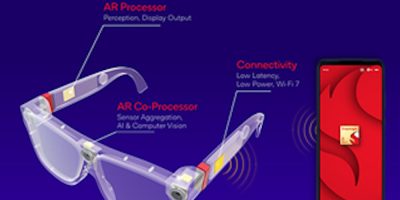Snapdragon AR2 exploits multi-chip architecture for AR
Qualcomm has unveiled what is claimed to be the world’s first purpose-built headworn augmented reality (AR) platform, Snapdragon AR2 Gen 1. It is part of Qualcomm’s extended reality (XR) portfolio.
The multi-chip architecture achieves 50 per cent lower power consumption and 2.5 times better AI performance, said Qualcomm, to enable high-performance, sleek AR glasses, unlocking a new generation of AR glasses for spatial computing experiences.
The multi-chip distributed processing architecture is combined with customised IP blocks. The main processor occupies a 40 per cent smaller PCB area on glass and consumes 50 per cent less power to help achieve AR glasses that consume less than 1W, confirmed Qualcomm. This enables glasses to be worn for extended periods of time.
The Snapdragon AR2 architecture includes an AR processor, AR co-processor and connectivity platform. Dynamically distributing the processing of latency-sensitive perception data directly on the glasses and offloading more complex data processing requirements to a Snapdragon-powered smartphone, PC or other compatible host devices, allows the design of the arm of the AT glasses to be slimmer.
The AR processor is optimised for low motion-to-photon latency while supporting up to nine concurrent cameras. Enhanced perception capabilities include a dedicated hardware acceleration engine that improves user motion tracking and localisation, an AI accelerator to reduce latency for sensitive input interactions such as hand tracking or six DoF (degrees of freedom) and a reprojection engine for a smoother AR experience.
The AR co-processor aggregates camera and sensor data and enables eye tracking and iris authentication for foveated rendering. This technique optimises workloads only where the user is looking and helps reduce power consumption.
The connectivity platform uses Qualcomm FastConnect 7800 connectivity to unlock Wi-Fi 7 technology and reaches less than two milliseconds latency between the AR glasses and the smartphone or host device. Embedded support for the FastConnect XR Software Suite 2.0 enables better control of XR data to improve latency, reduce jitter and avoid unwanted interference.
To support developers, Snapdragon AR2 and the Snapdragon 8 Gen 2 platform are optimised to be Snapdragon Spaces-ready.
“We built Snapdragon AR2 to address the unique challenges of headworn AR and provide industry-leading processing, AI and connectivity that can fit inside a stylish form factor,” said Hugo Swart, vice president of XR product management, Qualcomm Technologies.
“Microsoft worked closely with Qualcomm on the platform requirements for Snapdragon AR2 to help define the purpose-built, foundational technologies to unlock new possibilities in AR experiences,” added Rubén Caballero, corporate vice president of mixed reality, devices and technology, Microsoft.




